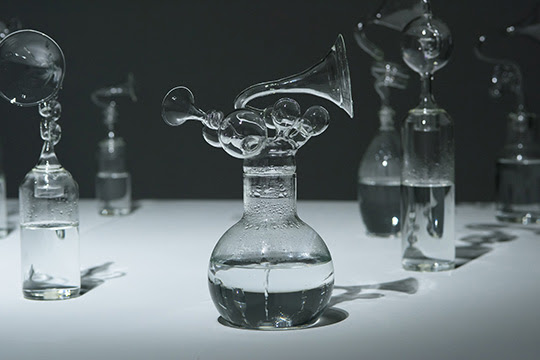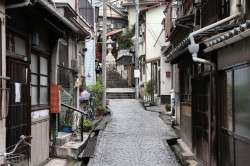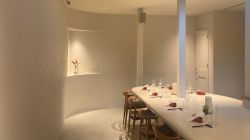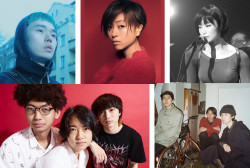
April 11, 2018
Chozumaki / Chijikinkutsu at Mizuma Art Gallery
Clever sound installation with a strong visual impression, sensual and unpretentious.
In a city as cluttered as Tokyo, space and silence are sacred. Though designated as a sound installation,“Chozumaki” by Akamatsu Nelo gives a strong visual impression, and the interplay between the senses is key to the appeal of the work. On entering Mizuma Art Gallery, an idiosyncratic medium-sized gallery hidden amongst the grey offices and universities of Ichigaya, you will be immediately struck by a number of curious glass objects displayed on a white table. Peculiar and otherworldly, yet somehow familiar, these glass vessels are filled with water. A small, winged magnet spinning at the bottom of each vessel produces a vortex. As tiny bubbles are swallowed into the vortex they produce curious sounds which reverberate around the dimly lit room.

Photography: AKAMATSU Nelo © AKAMATSU Nelo
Akamatsu reportedly intended to have the glass vessels play songs but decided this would be seen as contrived. Indeed, the highly individualized sounds wield a power that is strange but somehow refreshing, like the running of a stream, footsteps echoing around a chamber or bubbles popping. We hear the sounds through a spiral pipe and horn on the top of the vessels, shaped like the cochlear in the ear.
Look closely and you will see that the body of the glass vessels are sculpted in a way that suggests human organs. The lungs, the heart, the kidneys, they are all implied. None of the forms resemble the brain and this seems appropriate. There is something wonderfully earthy about the installation—it appeals to the physical rather than the cerebral. “Chozumaki” takes its name from chozubachi, a stone wash basin used to clean hands before a tea ceremony. Akamatsu cites influences on his work ranging from the metaphysical properties of tea ceremonies to the future of artificial intelligence, but these connections appear tenuous and perhaps unnecessary for the viewer. “Chozumaki” should be enjoyed sensually and not overthought.
Did you ever fill glasses with water to make a musical instrument as a child? “Chijikinkutsu,” in the adjacent room, will bring back those joyful, creative sensations. The title is a portmanteau of suikinkutsu, a sound installation for Japanese gardens invented in the Edo period, and chijiki, geomagnetism. Glass tumblers line the shelves and the floor of the room, each containing a needle submerged in water. The floating needles have been magnetized to be affected by geomagnetism and turn independently on a north-south axis. The sounds of them hitting the glass resonates around the space and it is a lot of fun to try and catch one moving by itself. While “Chijikinkutsu” is not as visually impressive as “Chozumaki,” it has a cleverness and joyfulness the other lacks. You are welcome to take off your shoes, sit on the black tatami mat (a rarity in Tokyo) and abide with the installation as long as you please.
“Chozumaki / Chijikinkutsu” runs until April 28. Go on your lunch break midweek to avoid the crowds.
11am – 7pm, closed Sundays, Mondays and National Holidays. Free entry. 2F Kagura Bldg., 3-13 Ichigayatamachi, Shinjuku-ku. Nearest station: Ichigaya. Mizuma-art.co.jp
Featured image:
Chijikinkutsu
2013
Water, glass tumblers, glass jars, sewing needles, copper wires, magnetite, electrical devices, controllers, PC
(Installation view, Takamatsu Media Art Festival, Tamamo Park Hiunkaku, Kagawa, Japan, 2015)
Photography by Nelo Akamatsu
© Nelo Akamatsu
Courtesy of Mizuma Art Gallery







